Personal Branding and Digital Citizenry: Harnessing the Power of Data and IoT - Juniper publishers
Journal of Trends in Technical and Scientific Research
Abstract
Personal branding is a way to elevate oneself in new
marketing concept. For many, building and managing a personal brand is
about value, mission, image, and vision. However, with the shift in the
marketspace and the rise of the Internet of Things (IoT), Personal
Branding has become a data function and a summation of all one’s digital
footprints, and how we are seen by Databots and not just as seen from
one’s own spectacles or as perceived by others. Consequently, we are
witnessing an upsurge in the use of deep machine learning and predictive
analytics to profile and select talents using their personal brand as a
data function of their web presence and digital citizenry. In order to
find out a solution, we conducted a survey and we observed how many
students are not fully aware of their web presence/digital citizenry and
how all their digital footprints from their social and professional
networks can and will be used to profile them. After identifying this
problem, we examined the idea of building and managing a personal brand-
with high value by exploring the depths of “Digital Citizenship”
concept.
To solve this problem, we developed a Personal
Branding tool that allows students to develop and promote their own
Personal Brand using a Digital Passport to express, share, and manage a
multi-dimensional, drill down-able, presentation of all their academic
and non-academic achievements, experiences, skills, interests, aptitudes
and career highlights in their own unique style. We also examine how
this Personal Branding tool can be used as a Digital Citizenry
application that allows students to become fully aware of their Web
Presence and manage, facilitate and monitor their Social and
Professional Networks with a built-in Digital Footprint Analyzer and
their very own Social Media manager.
Keywords: Digital
Citizenry Web Presence Digital Footprints Personal Branding Internet of
Things Predictive Analytics; Machine Learning Social Media Manager
Web 2.0
Introduction
Traditionally brands have been associated with
businesses, products, organization or services but today researchers
have recognized that brands can also be human [1,2]. Personal branding
has become an important marketing task for everyday people along with
celebrities and leaders in business and politics [3-7]. Web 2.0 has
developed a friendly platform for personal branding, including creation
of individual profiles and web pages [8,9] Web 2.0 focuses on
user-generated data which is easy to use and mostly generated by
non-experts [10]. As the job market is constantly changing, it becomes
necessary to make certain revisions to the current culture, mindset and
skills [10]. Significant efforts are required in order to succeed in the
current job market, which is competitive due to its challenges and
renovative updates. Hence to remain in synchronous with the various
changes happening around and expand network importance one should know
how to use it effectively.
Our motivation for this research was based on
hypothesis that the general populace has a lack of awareness regarding
the importance of monitoring online presence and has difficulty managing
vast resources available to them. We tried testing this theory.
Wescrutinized the way people consider their public data, represent their
image online and manner in which they store personal data. A person can
highlight him in a positive light, developing his online profile in
such a way that the networked audience will get involved by the fashion
data is represent but not in data. People who have succeed in their
respective domain obtain their reputation and position based on
combination of their proficiency and consistency which made them
attractive and gave them ability so that they can distinguish themselves
from others. And hence an authenticate personal brand should deliver
both a track record and a promise to deliver its value.
To find the solution we conducted a survey,
interviewed few students from the campus and completed literature
review. We found out that:
a) All final year students are working on the final year project so that they the potential employer can review them
b) Most students who are aspiring professionals need
to maintain a CAPSTONE equivalent for personal and Continuous
Professional Development (CPD)
c) More than half students are not aware of all their web
presence/digital citizenry and how their digital footprints
from their social and professional networks can be used to
represent them
The Wall Street Journal confirms that, “Companies are investing
in improving their online career portals, making their sites
easier to use, adding more detailed company and job information
and incorporating more social media. Job postings and text descriptions
of corporate culture have been supplemented with You-
Tube videos and blogs from employees, HR officials and even executives,
along with links to corporate Flickr, Facebook and Twitter
pages that chronicle life at the company and include job postings.”
Inextricably linked to one’s personal brand is their web presence,
particularly in the context of social media [11]. Web presence is
the public way an individual is observed from the point of view of
an audience while on the internet. The more connections people
make, the larger their digital footprint, and the more likely potential
employers would find fewer positive aspects of a person’s digital
life. This is important to consider, particularly when searching
for a career. However, no one lives in a vacuum, and digital connections
with friends, family members, or even professional contacts
is virtually inevitable in the world we live in today. According to
Brake, “Profiles and entries on Facebook, Twitter and many other
such services can contain confessional material that looks as if it
is only for the author to read or perhaps for trusted friends and
family - but although social media services often include tools to
keep such writings private, many are visible to a large number of
people or even published openly on the web with potential audience
of millions.”
The solution then is not simply to be aware, but to be able to
manage one’s image in the digital space, promoting positive aspects
while diminishing the aspects that are less so. In the article
by Harris & Rae, the authors state, “... the ‘‘digital divide’’ between
the ‘‘haves’’ and the ‘‘have nots’’ in the developed world is now
less about access to the web than it is about understanding how
to actively participate in the networked society.” Having the power
to manage one’s overall web presence is key to success in modern
times. The concept of Digital Content Storage is a library, a collection
place of all digital content that a person owns and uses. This
is similar to other methods used to save and share files of different
types and sizes, such as Dropbox or Google Docs. The app we are
presenting as a solution works in this same way, but with the added
bonus of the “vault” feature, which would be a specific space
located within the library with extra security features for more
sensitive and restricted document files and information.
Methods
In choosing a method of study we thought it would
appropriate
to make use of an online survey in order to reach a variety
of respondents in light of our triple constraints: we were able to
reach the highest amount of people in our given time by the most
cost-effective means. We conducted our study using Google forms.We
posted several links to our survey on Facebook and Twitter, in
order to gain a wide viewing and have the most success. Distributing
the survey in this way allowed us to get feedback from those
who may no longer be students or in the academic world and did
not assume any prior knowledge of our topics, giving us the widest
possible net to cast for data. This survey included questions based
on personal brand, web presence, and digital content storage,
gauging the participants both in their current knowledge of these
topics and also their current usage of applications and software/
hardware specific to these subjects. This initial survey was left
open for one week. We used the analytics provided by Google Docs
initially, and then used the raw data to analyze the information for
ourselves to make our conclusions. We split this survey into sections,
and each section was specific to one of the three topics we
were testing. This allowed us to get a somewhat general idea of the
prior knowledge our participants had for each of our topics. For
example, “Are you Familiar with Personal Brand?” was a specific
question we asked our participants in order to try to gain an
understanding
of what the general public might or might not already
know about the subject, an approach we felt was useful in giving
meaning to the survey.
Findings
The data we collected from our surveys proved to hold a number
of patterns which we found in the process of our analyzation.
Our initial survey collected data from 60 volunteer participants.
This gave us quite a bit of information, which was useful in gaining
knowledge from a large variety of data. One of our main interests
was in determining how important people considered their social
media presence. We were interested in the importance people put
on themselves and their personal media first. Our results showed
that over 50% of people placed themselves and their social media
in the mid-range. 81.67% of respondents rated their social media
at a 3 or higher on a scale of 1-5, with 66.67% rating themselves at
3 or 4, the middle rankings as depicted in Figure 1.
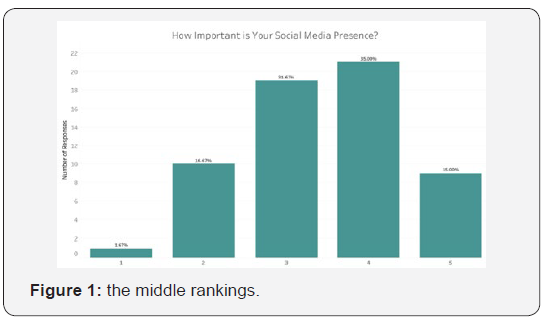
According to these results, gender is not a highly determining
factor when considering number of social media accounts currently
in use by users. This is especially interesting considering
the gender of respondents: as stated, 66% of respondents were
female and 33% male, and interestingly, our data shows a low level of disparity between the two. We determined that this further
proves that a better knowledge of one’s digital footprint is universally
beneficial shown in the following Figure 2.
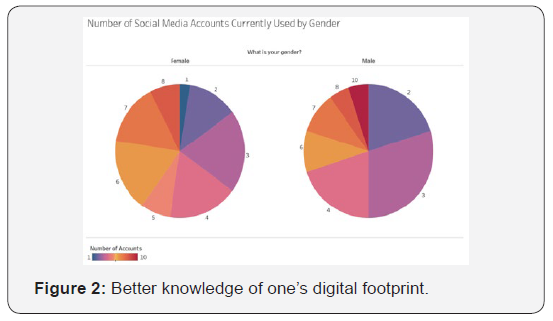
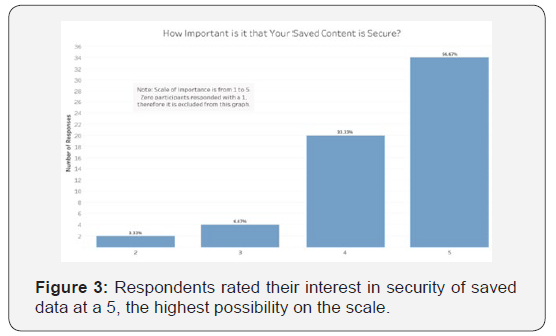
We were also very interested to see how highly people determine
the importance of security of their saved content, asking
them to rank that importance on a scale of 1-5. Interestingly, from
this data, we found that zero respondents rated their security importance
at one, the lowest. Alternatively, 56.67% of respondents
rated their interest in security of saved data at a 5, the highest possibility
on the scale, which shows very clearly how highly security
is considered as represented in the following Figure 3. Another
interesting pattern we found in our data was the distribution of
gender, in the way that affected our survey. In Figure 2, our respondents
were 66% female, 33% male, so we thought it prudent
to measure some of our responses by gender to find important
differences in the use of social media and web accounts.
The System: Personal Branding and Digital Citizenry
The collected data and various surveys lead us to develop a
system which will connect the students with recruiters and vice
a versa. The application we build is named as ‘Personal Branding
and Digital Citizenry’(PBDC). This application is nothing but
360 approach for students and ambitious professionals to be
accountable career owners and recruiters, admissions and employers
to accountably attract, manage, retain and grow talent.
While research phase we came across same system which manages
student data and support them while recruiting processnamed as e-Portfolio. We explore the various ways people use the
e- Portfolio for and make the affinity diagram from the collected
data so that we can categorized the feature which comes under
same category. That helped us to note down all the key features
of the e-Portfolio. There are few idiosyncratic features which we
included in PBDC like in build Digital Rights Management (DRM),
Copyright Tracking with Audit Trail and Version Control, Hold and
manage all types of files etc. These all feature are designed after
finding the loopholes in the system people are using currently and
from e-Portfolio. User journey of the Personal Branding and Digital
Citizenry (PBDC) is as shown in Figure 4.
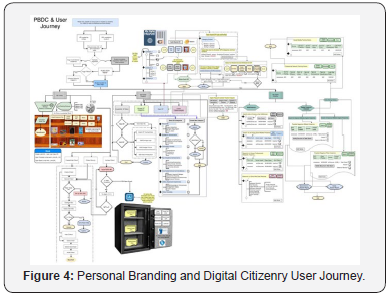
Unlike any of the e-Portfolios applications in the market, our
Personal Branding and Digital Citizenry (PBDC) system provides
both schools and professional organizations with: A Capstone and
Career Fair management apps allows the school to schedule and
manage a Capstone or a Career Fair event each term giving all
attendees, including potential employers a secure access to view
and rate students’ capstones or final course projects. A powerful
Personal Branding tool that allows students to develop and promote
their own Personal Brand and measure and manage their
career using a Digital Passport to express, share, and manage a
multi-dimensional, drill down-able, presentation of all their academic
and non-academic achievements, experiences, skills, interests,
aptitudes and career highlights in their own unique style.
A Digital Citizenry tool that allows students to
become fully
aware of their Web Presence and manage, facilitate and monitor
their Social and Professional Networks with a built-in Digital
Footprint Analyzer and their very own Social Media manager. A
personal and smart digital objects repository (My Library) that
interfaces
with the campus’ Learning Management Systems to allow
students to build, deposit, and maintain their own virtual library
shelves of all their favorites and must hang on to course materials
(i.e. lecturer and course projects and notes etc.), books/publications,
videos, and any other learning & content materials etc. (also
providing cheaper and more secure cloud storage). A personal and
secure (Digital Vault) hidden in one of the student’s virtual
libraryshelves allowing them to safeguard and protect their most
valuable
digital assets, documents, resources or artifacts etc. for added
security Blockchain will be added to this solution [12-14].
Conclusion and Future Scope
Because online branding has received more attention is was
necessary to design the system which should be different from the
e-Portfolio and we tried to be developed something which is different
from the e-Portfolio. Here we list few things which make
PBDC unique:
a. Built in Digital Rights Management (DRM)
b. Copyright Tracking with Audit Trail and Version Control
c. Hold and manage all types of files
d. Metadata for searching, browsing and discovery
e. Taxonomies & configurable workflows with user roles
and permissions
f. Access-controlled collections with customizable classification
g. Web service interfaces for:
i. Video streaming and transcoding services
ii. Content and assessment authoring tools
iii. Learning management systems (e.g. Moodle, Canvas etc.)
By providing best-in-class Personal Branding & Digital Citizenry
management support for students and aspiring career professional,
AND best-in-class management support for academic
admins, career services, recruiters/admission, and employers,
both campus and professional organizations will “revolutionize”
the way students manage their Personal Brand and careers.
To Know More About Trends in Technical and
ScientificResearch Please click on:
https://juniperpublishers.com/ttsr/index.php
To Know More About Open Access
Journals Please click on:
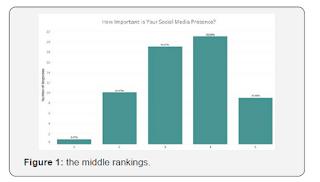


Comments
Post a Comment